Trying to decide between the 28 Nosler vs 7mm PRC vs 7mm Rem Mag cartridges? Here’s what you need to know about them.
I’ve never seen a cartridge make as big of a splash as the 7mm PRC did when it was introduced and lots of hunters are curious about how this brand new cartridge will perform afield. It’s only natural that many hunters would compare the brand new 7mm Precision Rifle Cartridge with the tried and true 7mm Remington Magnum and the hot rod 28 Nosler. All offer certain advantages to hunters, but there are some significant differences between the 28 Nosler vs 7mm PRC vs 7mm Rem Mag cartridges you should be aware of before purchasing a new rifle.
Both the 7mm Remington Magnum and the 28 Nosler are effective cartridges with loyal fan bases. However, the 7mm PRC has some noteworthy advantages over each one in various areas. Even so, the cartridge is not perfect and there are still reasons to like the venerable 7mm Rem Mag and the hopped up 28 Nosler.
In this article, I investigate the 28 Nosler vs 7mm PRC vs 7mm Rem Mag debate in detail and provide some insight into which 7mm Magnum rifle cartridge is ideally suited for various hunting situations so you can make an informed decision on which one will work best for your individual needs.
Before we get started, I have an administrative note for you.
Some of the links below are affiliate links. This means I will earn a small commission (at no extra cost to you) if you make a purchase. This helps support the blog and allows me to continue to create free content that’s useful to hunters like yourself. Thanks for your support.
Additionally, I recorded an entire podcast episode on this exact subject. If you’d rather listen than read, click the appropriate link below to listen to this episode on your preferred podcasting service.
7mm PRC vs 7mm Rem Mag vs 28 Nosler Podcast
Apple | Google | iHeart | Pandora | Spotify
History Of The 7mm Rem Mag, 28 Nosler, & 7mm PRC
The decades immediately following World War II saw a true renaissance of civilian firearm and cartridge development in the United States. That general time period saw a flood of new centerfire rifle cartridges like the .223 Remington, .243 Winchester, and .308 Winchester.
That same time period also saw the start of the modern “Magnum Era” when Winchester introduced a line of new belted magnum cartridges that utilized a modified .375 H&H case.
They introduced the .458 Winchester Magnum first in 1956 and then released the .264 Winchester Magnum and the .338 Winchester Magnum during the next couple of years.
All of those cartridges utilized a .375 H&H Magnum case necked down (or up, in the case of the .458 Win Mag) and shortened from 2.85″ to 2.5″ long.
The designers used those shortened cases so all three new cartridges would fit in a standard length rifle action (same as the .270 Winchester and .30-06 Springfield) instead of the longer magnum length action required by the original .375 Holland & Holland Magnum cartridge.
Those cartridges all saw a good deal of commercial success and nobody was really surprised when Remington took a page out of Winchester’s playbook and introduced their own belted magnum cartridge in 1962: the 7mm Remington Magnum.
Often referred to as the 7 mm Rem Mag, 7mm RM, or 7mm Mag, the new Remington cartridge also used a necked down and shortened .375 H&H Magnum case.
Instead of using .264″, .338″, .458″, and later .308″ bullets like Winchester did with their magnums, Remington loaded their new cartridge with .284″ bullets.
The .30-06 Springfield was (and remains) the gold standard by which most similar cartridges are judged. Well, the use of the larger case based on the .375 H&H along with the use of smaller diameter 7mm/.284″ bullets by the 7 mm Remington Magnum resulted in a significant ballistic improvement over the .30-06.
Indeed, the 7mm Mag will shoot the same weight bullet faster than the .30-06.
Additionally, the narrower .284″ bullets the 7mm Mag uses have a higher ballistic coefficient and more sectional density than .30 caliber bullets of the same weight used by the .30-06 Springfield.
For those reasons, typical 7mm Rem Mag loads have a flatter trajectory, have more energy remaining downrange, and (all other things equal) will penetrate better than .30-06 Springfield loads using the same weight bullets.
Like the new Winchester Magnum cartridges, the new 7mm Remington Magnum cartridge also fit in a standard length rifle action. And to top it all off, the 7mm Remington Magnum was rolled out at the same time as the now legendary Remington Model 700 rifle.
So, American hunters and shooters were immediately offered the chance to use a new high performance cartridge that was available in a well built, reasonably priced, and very accurate new rifle.
With all that in mind, it’s not surprising at all that the flat shooting and hard hitting 7mm Rem Mag quickly caught on with hunters and shooters in North America.
The 7mm Rem Mag remains extremely popular among hunters to this day.
However, there’s another heavy hitting magnum cartridge that really sticks out from the crowd: the 28 Nosler.
Nosler initially made a name for itself in the hunting community by developing revolutionary hunting bullets like the Nosler Partition, Nosler AccuBond, Nosler Expansion Tip (E-Tip), and Nosler Ballistic Tip during the second half of the 20th Century and early 21st Century.
Well, Nosler dove headfirst into the cartridge development world with the introduction of their new 26 Nosler rifle cartridge in 2013.
The name “26 Nosler” reflects both the name of the company as well as the first two digits of the cartridge bullet diameter (.264″ in the case of the 26 Nosler cartridge).
Based on a slightly modified 404 Jeffery case necked down to shoot .264″ bullets, the 26 Nosler was definitely in the running for the title of the “world’s most powerful 6.5mm commercial cartridge.”
The 26 Nosler was a big enough commercial success that Nosler introduced the 28 Nosler, which fires 7mm/.284″ bullets, as the next addition to their line of Nosler Proprietary Cartridges in 2015.
Like the 26 Nosler, the 28 Nosler also uses a modified 404 Jeffery case that’s necked down and shortened to fit in a standard 30-06 length action. They decided to use a 1:9 rifling twist rate for the 28 Nosler that’s optimal for long, high BC 7mm/.284″ bullets like their 175gr AccuBond Long Range bullet.
The end result is a massively powerful cartridge capable of launching those heavy for caliber and extremely aerodynamic bullets at muzzle velocities in excess of 3,100fps. The cartridge is also capable of firing lighter 140gr, 150gr, and 160gr bullets approximately 200-300fps faster than the old 7mm Rem Mag.
Not surprisingly, the flat shooting and hard hitting 28 Nosler is a favorite among hunters after big game like elk who want a cartridge that offers excellent performance at extended range.
The success of the 26 and 28 Nosler spurred the development of additional Nosler cartridges. As of 2022, the lineup of Nosler cartridges also includes the 22 Nosler (.224″ caliber) introduced in 2017, the 27 Nosler (.277″ caliber) introduced in 2020, the 30 Nosler (.308″ caliber) introduced in 2016, and the 33 Nosler (.338″ caliber) introduced in 2016.
Of all those, the 28 Nosler is by far the most popular as I write this article and has a loyal following among those who appreciate the hard hitting long range performance the cartridge delivers.
As good as the Nosler cartridges are though, Hornady designed their new series of Precision Rifle Cartridges to go about delivering a similar level of hard hitting performance on game at long range in a slightly different manner.
The 6.5 PRC and the 300 PRC were the first two members of the family and both hit the market around the same time a few years ago. Initially designed to serve very different needs, the two cartridges were somewhat closely related and also incorporated many of the same design features: a long head height, a long case neck, a relatively fast rifling twist rate, and some specific chamber design features to enhance accuracy.
Additionally, those cartridges use modified .375 Ruger cartridge cases. The .375 Ruger was designed with the same .532″ case head diameter as the .375 H&H. However, unlike the .375 H&H (and cartridges like the 7mm Remington Magnum and .300 Winchester Magnum descended from it) the .375 Ruger is a beltless cartridge with minimal taper, so the actual body of the .375 Ruger case is larger in diameter than the .375 H&H.
This results in a slight increase in case capacity for the 375 Ruger (and all cartridges descended from it) while still working with a standard magnum bolt face.
Head height is the amount of space available for the bullet outside the case while staying within SAAMI specifications for the cartridge. Put simply, more head height facilitates the use of very long, aerodynamic bullets without requiring them to be seated so deeply into the case that they intrude into the powder column.
In that same vein, rifles chambered in Precision Rifle Cartridges typically have a relatively fast rifling twist rate (usually 1:8″) in order to stabilize those long, heavy, high BC bullets. They’re also built with a long enough case neck to provide adequate neck tension with those long bullets, which can help with accuracy.
They also have a relatively “tight” freebore diameter.
Freebore is the smooth portion of a rifle barrel closest to the cartridge. Having a more snug freebore diameter means there’s less room for the bullet to yaw upon firing before engaging the rifling. This can also help enhance accuracy.
The end result was that both the 6.5 PRC and 300 PRC were optimized to accurately shoot very long, sleek, high BC bullets at magnum velocities.
Well, the success of the 6.5 PRC and 300 PRC had many in the shooting community clambering for a 7mm PRC to fill the gap between the little 6.5 and the much larger 300 PRC.
They got what they asked for when Hornady received formal SAAMI certification for the 7mm PRC in 2022 and then officially announced the new cartridge to the world later that year.
Instead of attempting to push a bullet with a moderately high BC as fast as possible in a long action rifle (like Nosler did with the 28 Nosler), Hornady designed the 7mm PRC to fire heavier bullets with an insanely high Ballistic Coefficient right at 3,000fps. Plus, they also incorporated those aforementioned design features into the cartridge design to improve the overall accuracy potential for the new cartridge.
The end result is a cartridge that’s extremely efficient and generally isn’t difficult to tune for accuracy that uses very high BC bullets which hang onto velocity and buck the wind surprisingly well as they travel downrange.
You can learn more about the 7mm PRC and how the that cartridge compares to other cartridges like the 6.8 Western and 300 Winchester Magnum in the articles below:
6.8 Western vs 7mm PRC Comparison
7mm Rem Mag vs 7mm PRC vs 28 Nosler Cartridge Sizes
You can see similarities and differences between the 7mm Rem Mag, 7mm PRC, and 28 Nosler in the photos below.
First, while the 28 Nosler has a slightly larger rim diameter than the other two (.532″ for the 7mm Rem Mag and 7mm PRC vs .534″ for the 28 Nosler), they all use a larger diameter cartridge case and require a larger magnum bolt face.
The 28 Nosler also has a rebated rim while the other two do not.
Since they’re descended from different cartridges (the 375 H&H belted magnum for the 7mm Rem Mag and the beltless 404 Jeffrey and 375 Ruger for the 28 Nosler and 7mm PRC respectively), the 7mm Rem Mag uses a belted case while the 28 Nosler and 7mm PRC have a beltless case.
Furthermore, it’s important to note that the actual case diameter of the 28 Nosler (.55″) and 7mm PRC (.533″) is larger than the non-belted portion of the 7mm Rem Mag case (.513″).
Additionally, the 7mm Remington Magnum has a 25 degree shoulder angle, the 7mm PRC has a 30 degree shoulder angle, and the 28 Nosler has an even steeper 35 degree shoulder angle.
Next, though the 28 Nosler and 7mm PRC have a slightly longer overall length than the 7mm Rem Mag, all three cartridges are designed for use in a long or standard length action.
Next, the 28 Nosler and 7mm Rem Mag both have a slightly longer case length than the 7mm PRC.
This goes back to what I was saying about head height earlier and the 7mm PRC has the most head height out of these three cartridges.
That comes at the expense of powder capacity here though.
In fact, the 7mm PRC actually has the least powder capacity of the group (about 3-4% less than the 7mm Rem Mag).
The giant 28 Nosler case has a slightly larger case capacity and can hold quite a bit more powder than the 7mm Remington Magnum and the 7mm PRC: about 22% more than the 7mm Rem Mag and about 26% more than the 7mm PRC.
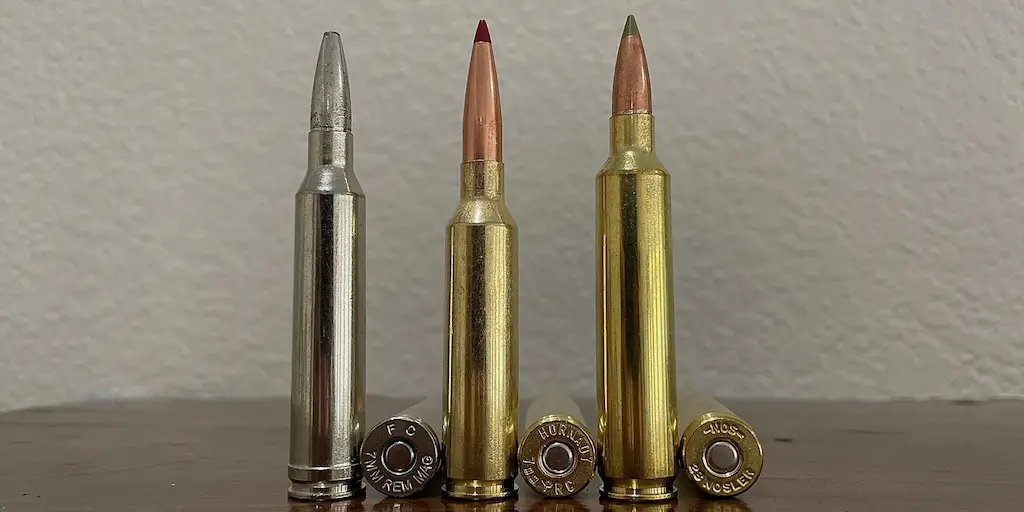
While all three cartridges use the same .284″ diameter bullet, bullet weight is another important difference between the 7mm Rem Mag vs 7mm PRC vs 28 Nosler.
First, most 7mm Rem Mag factory loads shoot bullets in the 139-175 grain range. 140 grain, 150 grain, 160 grain, and 175 grain loads are by far the most common.
It’s important to note that the 7mm Rem Mag isn’t optimized for performance with long, sleek, high BC bullets though.
Indeed, the high BC bullets for the 7mm Rem Mag tend to top out in the 162-168gr range, like the 162gr ELD-X, 168gr Berger Hybrid Hunter, or 168gr AccuBond Long Range.
As you can see in the photo below comparing a 162gr ELD-X to the 175gr ELD-X available in 7mm PRC factory loads, the 162gr ELD-X is noticeably shorter and has a lower BC (.631 vs .689).
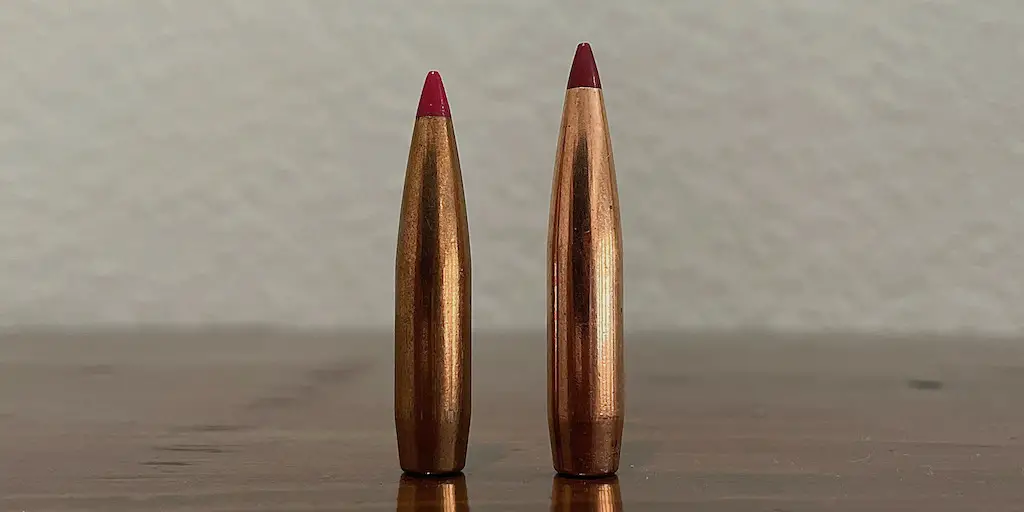
So, most 175gr loadings for the 7mm Rem Mag use shorter and lower BC pointed soft point or round nose bullets like the 175gr Core Lokt, Power Shok, and Trophy Bonded Bear Claw (that’s actually the 7mm Rem Mag load used in most of the other photos in this article).
For example, the 162gr ELD-X is 1.48″ long and the 168gr AccuBond Long Range is 1.5″ long.
The 175gr AccuBond Long Range is 1.54″ long and 175gr ELD-X is a whopping 1.585″ long.
To put things in perspective, the 7mm 175gr Trophy Bonded Bear Claw is a very heavy for caliber lead core bullets that’s not especially sleek or aerodynamic (G1 BC .407). At just 1.41″ long, it’s quite a bit shorter than even the 162gr ELD-X.
The situation is similar with monometal loadings, which usually top out around 150gr for the 7mm Rem Mag, like the 140gr and 150gr TTSX and Trophy Copper loads from Barnes and Federal and the 150gr CX from Hornady. There are some 7mm Rem Mag loads with a 160gr TSX, but that’s the non-tipped version of the TSX and has a lower BC.
Yes, it’s possible for handloaders to use heavier and higher BC lead core and monometal bullets in the 7mm Rem Mag, but the cartridge is not optimized for use with bullets like the 160gr CX or 168gr LRX and performance can be uneven.
Plus, that’s also just not an option for those who don’t handload.
Moving on, the 28 Nosler most often uses bullets in the 150-185gr range in factory loads. 150gr, 155gr, 160gr, 162gr, and 175gr bullets are the most common for that cartridge.
The fact that the 28 Nosler is available with that high BC 175gr AccuBond Long Range bullet from Nosler (.648 BC) as a factory load is an especially important advantage of this cartridge.
Finally, the 7mm PRC most often uses bullets in the 150-180 grain range, with 160 grain bullets, 175 grain bullets, and 180 grain bullets being most common. In particular, it was specifically designed from the start to use high BC 160gr monometal and 175gr and 180gr lead core bullets.
Why is there a difference in bullet weights for these 7mm cartridges?
Two primary reasons: rifling twist rate and head height.
The 7mm Rem Mag and the 28 Nosler both have SAAMI spec rifling twist rates of 1:9.5″ and 1:9″ respectively while the 7mm PRC has a faster SAAMI specified rifling twist rate of 1:8″.
Additionally, the greater head height of the 7mm PRC gives that cartridge more space to use a really long, high BC bullet that still fits in a standard length rifle action and magazine and without seating the bullet so deep into the case that it intrudes on the powder column.
Finally, the 28 Nosler and 7mm PRC are loaded to a higher SAAMI maximum average pressure of 65,000psi vs just 61,000psi for the 7mm Rem Mag.
Note: while the powder capacity figures listed below do give a good indication of the differences between the two cartridges, exact case capacities vary slightly according to the brand of brass used.
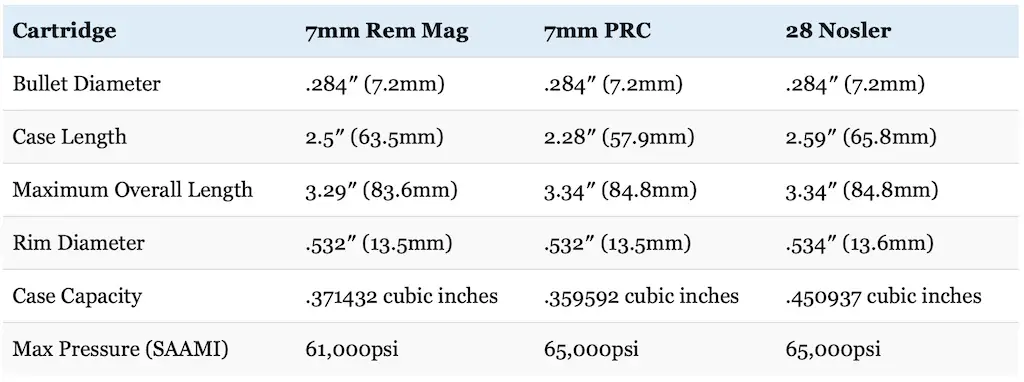
28 Nosler vs 7mm PRC vs 7mm Rem Mag Ballistics
The differences in the external dimensions of these cartridges also translate into some stark differences in their ballistic performance. This is illustrated in the table below comparing Hornady Outfitter and Hornady Precision Hunter factory ammunition for each cartridge.
The 28 Nosler is available in the Precision Hunter line, but not the Outfitter line. For this reason, I included a 28 Nosler load using a 150gr Nosler E-Tip (which is similar to the CX). Furthermore, I couldn’t do a comparison involving the 28 Nosler without the flagship 175gr AccuBond Long Range load, so I included it as well.
The 7mm Remington Magnum loads use 150gr CX (.455 BC) and 162gr ELD-X (.631 BC) bullets.
The 7mm PRC loads use 160gr CX (.596 BC) and 175gr ELD-X (.689 BC) bullets.
The 28 Nosler loads use 150gr E-Tip (.498 BC), 162gr ELD-X (.631 BC), and 175gr AccuBond Long Range (.648 BC) bullets.
Note: the CX and E-Tip are lead free monolithic projectiles designed by Hornady and Nosler respectively to deliver high weight retention and deep penetration. However, as a monolithic projectile, those bullets do not have nearly as high of a BC as the ELD-X or ABLR projectiles.
Additionally, while the ELD-X and AccuBond Long Range are designed to expand at velocities as low as 1,350fps (for the ABLR) or 1,600fps (for the ELD-X), the E-Tip and CX require a faster impact velocity of at least 1,800fps (for the E-Tip) or 2,000fps (for the CX).
Before going into the details of comparing the ballistics of those cartridges, I want to point out that the various bullets used in those 7mm PRC loads all have a higher BC than those used in the comparable 7mm Rem Mag and 28 Nosler loads.
All seven loads used a 200 yard zero.
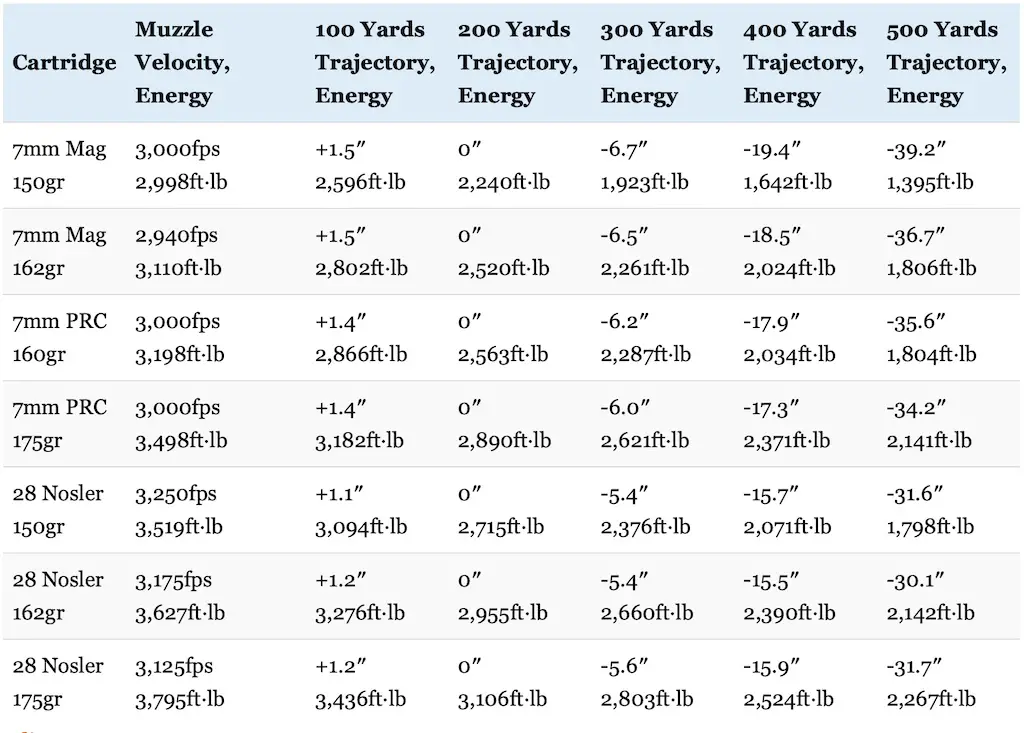
As you can see, the 28 Nosler 150gr E-Tip, 162gr ELD-X, and 175gr ABLR loads are actually the flattest shooting loads of the bunch! That really says something when a monometal bullet like the 150-grain E-Tip is shooting flatter than lead core projectiles in other high performance cartridges.
This is due to the fact that all three of those 28 Nosler loads have a higher muzzle velocity than either the 7mm Rem Mag or the 7mm PRC. Heck, the 28 Nosler is flinging a 175gr bullet 125-185fps faster than the 7mm Rem Mag shoots a 162gr bullet or the 7mm PRC shoots a 160gr bullet.
However, all these loadings (but especially the 7mm PRC and 28 Nosler) are relatively flat shooting and just 9.1″ separates the flattest shooting load from the most arching load at 500 yards. Dropping that 150gr CX load for the 7mm Rem Mag results in just 6.6″ of separation at 500 yards.
Not surprisingly, the 28 Nosler also has more muzzle energy across the board than the 7mm Rem Mag and 7mm PRC. Even so, the 7mm PRC still does pretty well here and both loads for that cartridge carry over 1,800 ft-lbs of kinetic energy out past 500 yards (over 2,100ft-lbs in the case of the 175gr ELD-X).
When compared to the 7mm Rem Mag, the various 7mm PRC loads have about 3-17% more muzzle energy. At 500 yards, the 162gr load for the 7mm Rem Mag and 160gr CX load for the 7mm PRC have almost exactly the same amount of energy remaining.
Think about that for a second too.
That Precision Hunter loading for the 7mm Rem Mag is a fantastic load using one of the highest BC bullets available for that cartridge in a factory offering, but the 7mm PRC has a load using a much tougher monometal bullet that shoots a tiny bit flatter and has basically the same amount of retained energy at 500 yards!
That sort of performance with a monometal bullet was basically unheard of until now.
Additionally, the much higher BC 175gr ELD-X load has 18-53% more retained energy than both 7mm Rem Mag loads at 500 yards.
Both 7mm PRC loads shoot a little flatter than both 7mm Rem Mag loads with 1.1-5″ less bullet drop at 500 yards though.
On the other hand, the various 28 Nosler loads have about .5-19% more muzzle energy than the 7mm PRC. The 175gr ABLR loading for the 28 Nosler has about 6-26% more energy than the 7mm PRC loadings at 500 yards.
However, the 175gr ELD-X loading for the 7mm PRC actually “catches” the 150gr E-Tip loading for the 28 Nosler just under 100 yards in terms of kinetic energy and actually has about 19% more kinetic energy at 500 yards.
Interestingly, things are similar with the 160gr CX and the 175gr ELD-X loadings for the 7mm PRC and those two loads also “catch” the 150gr E-Tip and the 162gr ELD-X loadings for the 28 Nosler respectively out around 500 yards.
This is because those two 7mm PRC loads use much more aerodynamic bullets than the comparable 28 Nosler loads.
At the same time, the 28 Nosler has about 13-26% more muzzle energy and 19-62% more retained energy than the 7mm Rem Mag at 500 yards. The 150gr E-Tip load is an exception here and the 162gr ELD-X load from the 7mm Rem Mag actually has a tiny bit more retained energy at 500 yards.
Additionally, all the loads in this comparison easily maintain at least 1,000 ft-lbs of energy out past 500 yards. Everything but the 7mm Rem Mag 150gr CX load has at least 1,500 ft-lbs of energy at that range and the 7mm PRC 175gr ELD-X as well as the 162gr and 175gr 28 Nosler loads maintain over 2,000ft-lbs of energy past 500 yards.
So, the big takeaways so far are that the 28 Nosler is the flattest shooting cartridge of the bunch and that 175gr ABLR load has the most retained energy at 500 yards, but the more efficient 7mm PRC holds its own pretty all and is either closing in on or has already surpassed the various 28 Nosler loads at 500 yards.
The 7mm Rem Mag performs pretty well on the whole, but clearly lags the 7mm PRC and 28 Nosler in terms of both trajectory and retained energy.
Interestingly, that 150gr E-Tip load for the 28 Nosler looks great on paper at first, but rapidly loses steam in spite of its blazing fast muzzle velocity since it uses a comparatively low BC bullet.
Those trends continue as we look out to even longer ranges. Note that I’m not advocating using any of these cartridges for hunting at extreme range, but things start to get pretty interesting as ranges increase.
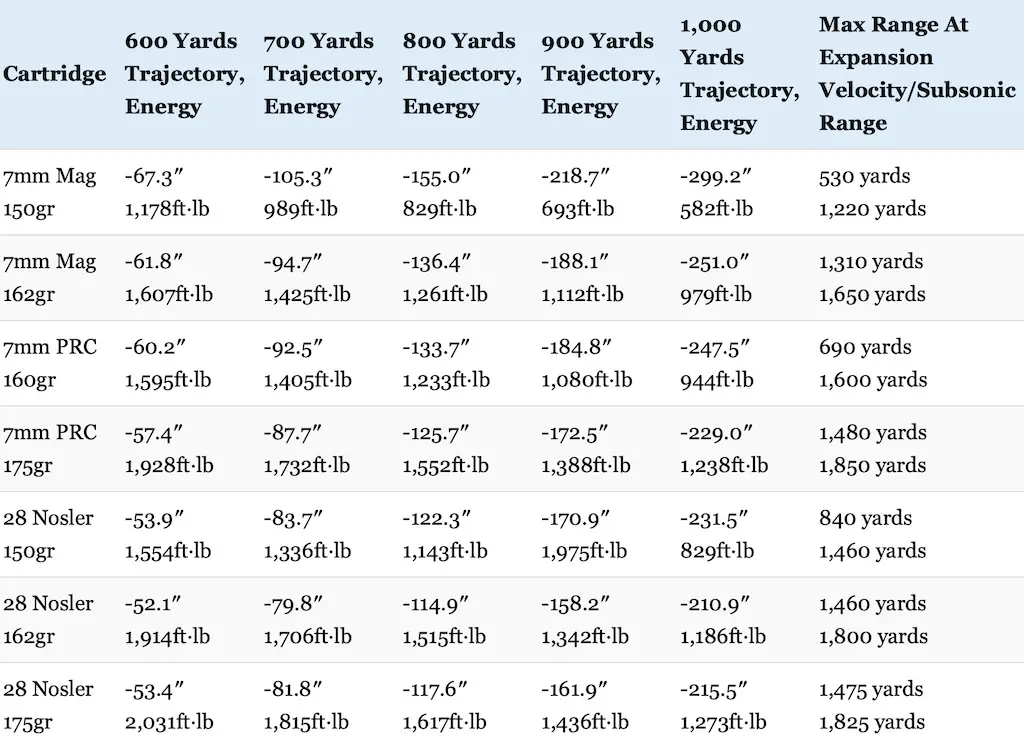
Once again, the 28 Nosler has the flattest trajectory of the bunch.
Interestingly, the 175gr ELD-X loading for the 7mm PRC has nearly the same amount of kinetic energy remaining at 1,000 yards as the 175gr ABLR loading for the 28 Nosler. Once again, this is because that 175gr ELD-X has the highest BC of all bullets used in this comparison which allows it to retain energy and velocity better than everything else.
Aside from trajectory (where the 28 Nosler load still has a good advantage), those two 175gr loadings are basically identical out past 600 yards when the 28 Nosler kinetic energy advantage drops below 100 ft-lbs (and continues to fall as range increases).
Those two loadings also dip below their minimum recommended impact velocities and finally go subsonic at virtually the same range as well.
Now let’s talk about another important factor: wind.
The chart below compares how much a 10 mile per hour crosswind impacts those same 7mm Rem Mag, 7mm PRC, and 28 Nosler loads out to 500 yards.
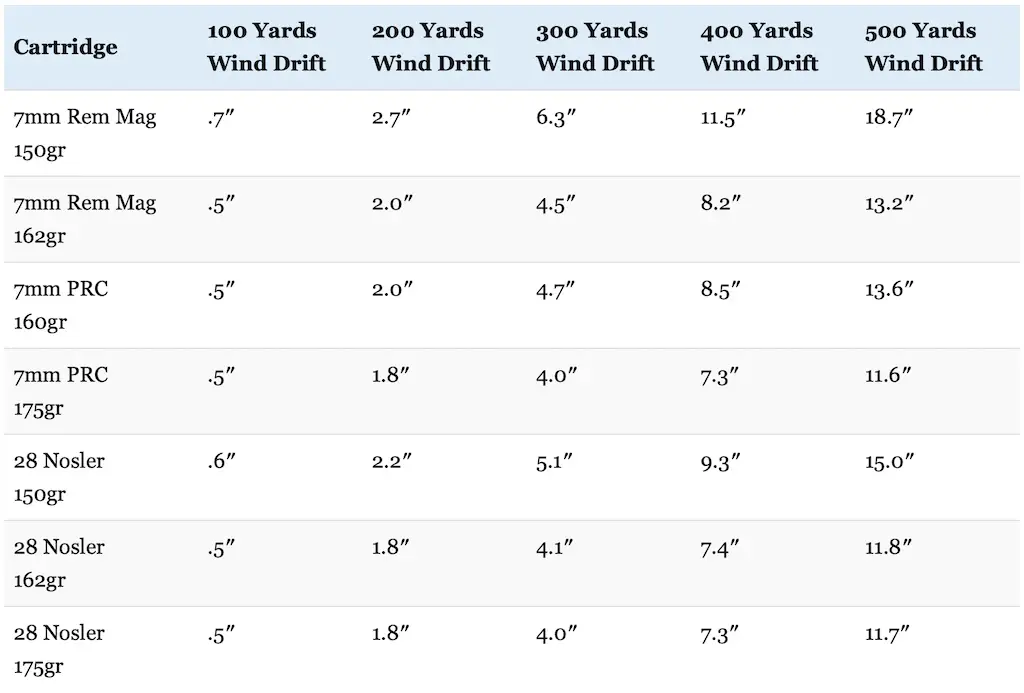
Those same general trends hold true with regards to wind deflection, but this is where that 175gr ELD-X load for the 7mm PRC really starts to stand apart from the others.
The 7mm PRC ELD-X has the least wind deflection, followed by the 28 Nosler ABLR, the 28 Nosler ELD-X load, the 7mm Rem Mag ELD-X, the 7mm PRC CX load, the 28 Nosler E-Tip load, and finally the 7mm Rem Mag CX.
While all of these loads (but to a lesser extent with the 150gr CX) have excellent wind bucking characteristics, the 175gr ELD-X, the 175gr ABLR, and the 162gr ELD-X from the 28 Nosler all have virtually identical wind deflection out at 500 yards.
I’d go so far as to say that having less than 12″ of wind deflection at 500 yards with a 10 mph full value crosswind is absolutely outstanding. Indeed, those three loadings deliver some of the best performance in windy conditions currently available for big game hunting ammo right now.
That 160gr CX also has virtually the same amount of wind deflection as the 162gr ELD-X from the 7mm Rem Mag at 500 yards as well (which is still really good).
The 7mm Rem Mag and 7mm PRC Precision Hunter loads look pretty closely matched in this area at first. However, while that 1.6″ of difference in wind deflection between the 175gr ELD-X and the 162gr ELD-X from the 7mm Rem Mag at 500 yards might not sound like a tremendous amount, that’s still a 12% advantage in favor of the 7mm PRC.
Those differences become even more apparent at longer range though.
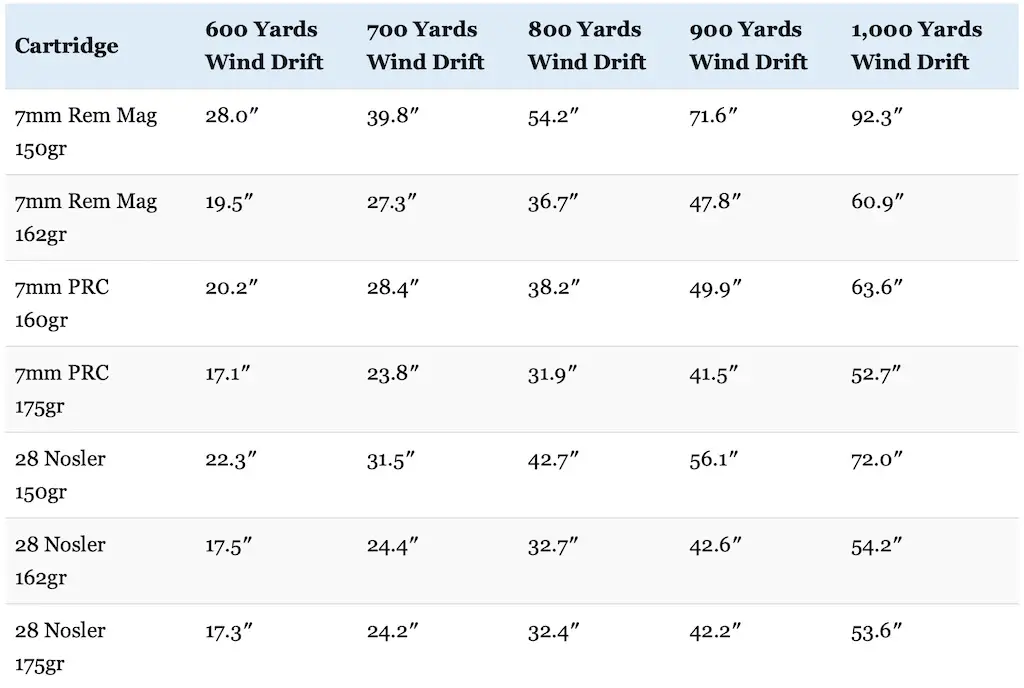
For instance, the advantage that 175gr ELD-X load has over the 162gr and 175gr 7mm Rem Mag and 28 Nosler continues to grow as the range increases.
This is an area where the 28 Nosler really shines with a combination of a high muzzle velocity and a very high BC bullet in the 175gr ABLR. Indeed, it performs a lot better than most comparable loadings at extended range.
However, a hunter or shooter looking for that little bit of an advantage would be well served to look at the 175gr ELD-X loading for the 7mm PRC here.
Why is this the case?
Assuming the same wind conditions, wind deflection is dependent on bullet velocity and BC. However, small changes in ballistic coefficient result in bigger changes in wind deflection than is the case with velocity.
For this reason, the 7mm PRC load firing the super high BC 175gr ELD-X comes out on top here.
Note the ELD-X loadings for each cartridge (and the ABLR for the 28 Nosler) start to leave the rest of the bullets in the dust with wind deflection due to their much higher BC as range increases.
External ballistics don’t tell the whole story though and there’s more to picking a hunting cartridge than kinetic energy, bullet drop, or wind drift at various ranges.
For instance, now let’s talk about recoil.
The table below compares the recoil produced by handloads that are very similar to the loads with the heaviest bullet weights compared above for the 7mm Rem Mag, 7mm PRC, and 28 Nosler when fired from identical rifles.
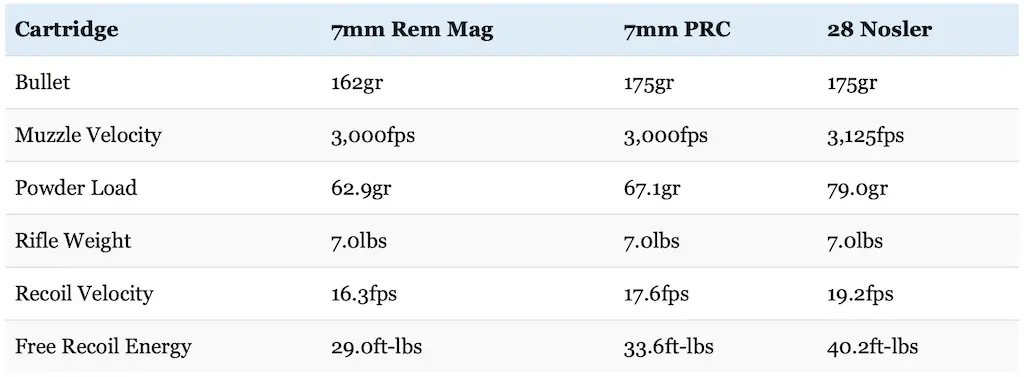
Felt recoil will vary from shooter to shooter and rifle to rifle, but free recoil energy is still a useful way to compare cartridges.
As you can see, the three cartridges all have fairly stout recoil, but the 28 Nosler has quite a bit more than the 7mm Rem Mag and 7mm PRC with this particular loading.
It’s true that 175gr AccuBond Long Range load looks really good on paper for the 28 Nosler. However, that performance comes at the price of more recoil.
That load fires a heavy bullet at a much faster velocity and uses a lot more powder to achieve that performance. The end result is that the 28 Nosler has about 20% more free recoil energy than the 7mm PRC and about 39% more recoil than the 7mm Rem Mag.
The 7mm Rem Mag and 7mm PRC are more closely matched here with the 7mm PRC having about 16% more free recoil energy than the 7mm Rem Mag.
Now, even the 28 Nosler doesn’t have a ridiculous amount of recoil. The recoil produced by this particular load is getting up there and is certainly stout, but it’s also not so excessive that it’s impossible to shoot.
On the other hand, the 7mm PRC is a very shootable cartridge.
For reference, my 7mm PRC has noticeably less recoil than typical .300 Win Mag loads.
While the 7mm Rem Mag does indeed have less, I feel like both cartridges have the sort of recoil that many people can handle without a lot of trouble, especially when shooting a rifle that fits them well, that has a good recoil pad, or is equipped with a muzzle brake or suppressor.
Even so, it’s still worth mentioning that the 7mm PRC does kick more than the 7mm Rem Mag and the 28 Nosler kicks quite a bit more than either one.
Don’t underestimate the impact that recoil has on the ability of a person to shoot accurately either. Some people do handle recoil better than others, but all other things being equal, they will absolutely shoot more accurately with a milder recoiling cartridge.
Additionally, there are a couple of other factors that are also worth discussing.
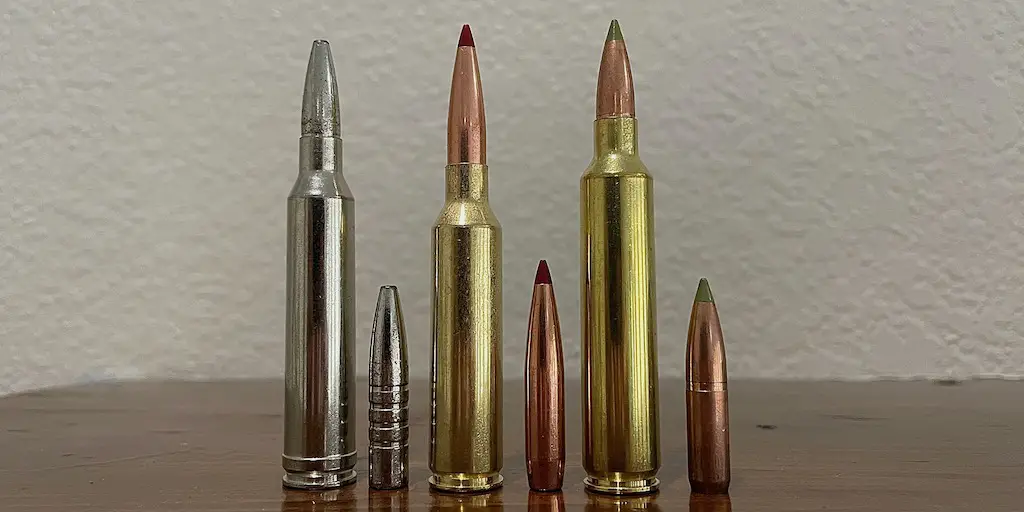
Even though all three cartridges use the same diameter bullet, the 7mm PRC also has a slight edge over the other two in terms of bullet sectional density.
Sectional density (SD) is a measure of the ratio of the diameter of a projectile to its mass.
All other things equal, a heavier bullet of a given caliber will be longer and therefore have a higher sectional density and consequently penetrate deeper than projectiles with a lower mass and sectional density.
Well, the 175gr loadings for the 7mm PRC and 28 Nosler are evenly matched here, but the 175gr ELD-X has an edge over the 162gr ELD-X here (.310 vs .287). The same is true for the 160gr CX (.283) vs the 150gr CX and 150gr E-Tip (.266).
To be fair though, the 175gr Accubond Long Range is generally a tougher bullet than the 175gr ELD-X because it has a bonded core (which the ELD-X lacks). All other things equal, I’d expect the 175gr ABLR to penetrate a little deeper than the 175gr ELD-X and retain a little more weight.
On the other hand, those new, heavy, and extremely aerodynamic .284″ caliber bullets used by the 7mm PRC also have a relatively high ballistic coefficient.
The bullets used in this comparison illustrate those differences well with the 7mm PRC using 160gr (.596 BC) and 175gr (.689 BC) bullets outclassing the 150gr (.455 BC) and 162gr (.631 BC) bullets used by the 7mm Rem Mag as well as the 150gr (.498 BC), 162gr (.631 BC), and 175gr (.648 BC) bullets used by the 28 Nosler.
28 Nosler vs 7mm PRC vs 7mm Rem Mag Barrel Life
While the three cartridges have the same bore diameter and have a similar case capacity, throat erosion occurs faster with the 28 Nosler because it uses the most powder. Simply put, burning a lot more powder in the same amount of space will result in shorter barrel life.
This means that, in general, the 28 Nosler will simply wear out barrels faster than the 7mm Remington magnum and 7 mm PRC will. Exactly how fast that occurs depends on a number of factors like the quality of the barrel, the exact ammunition used, etc.
The details will vary, but it’s not unheard of for some 28 Nosler rifles to see a drop off in accuracy after just a few hundred rounds. Others will last 800-1,000 rounds, but it’s unusual to hear of them lasting much longer than that with full powered ammunition.
The good news for hunters is that typical barrel life for even the 28 Nosler is more than enough to last for many years of hunting with no issues. Exactly when the barrel is unusable depends on the rifle as well as the hunter in question and what sort of performance they expect from their rifle.
Those who want extremely tight groups for long range shooting are probably going to want to change their barrel out sooner than those with slightly lower standards.
What about the 7mm Rem Mag and 7mm PRC?
All other things being equal, rifles in those chamberings will probably have a longer barrel life than those in 28 Nosler. 1,500-3,000 rounds is thrown around a lot of the 7mm Rem Mag, but it really varies on a number of factors.
The situation will probably be similar with the 7 mm Precision Rifle Cartridge (which has a tiny bit less powder capacity than the 7mm Rem Mag), but it’s such a new cartridge that there’s not a lot of real world data on barrel life quite yet.
Both will probably last longer than a 28 Nosler barrel though.
What about 28 Nosler vs 7mm PRC vs 7mm Rem Mag accuracy?
While external ballistics are extremely important, performance on paper doesn’t mean a darn thing if you can’t hit your target.
Like I mentioned earlier, Hornady implemented some design principles with the 7mm PRC to help optimize accuracy. Specifically, they built the cartridge with a tight freebore diameter.
Freebore is the smooth portion of a rifle barrel closest to the cartridge. Having a more snug freebore diameter means there’s less room for the bullet to yaw upon firing before engaging the rifling. This can also help enhance accuracy, especially with extremely long bullets.
So, the designers at Hornady built the all the Precision Rifle Cartridges with a tight freebore diameter in a manner similar to what they also did with the 6.5 Creedmoor and what Winchester did with the 6.8 Western.
As good as the 28 Nosler is (and it is an excellent performing cartridge), the 28 Nosler is also known for being overbore. Some also compare this fire breathing magnum to a hot rod car: it has plenty of juice, but also needs to be tuned appropriately for best performance.
That’s not to say that the 28 Nosler isn’t capable of great accuracy (because it is). However, it’s also known for being finicky.
Those concerns are much less of an issue with the more efficient 7mm PRC.
In any case, the details will vary on the exact rifle, ammunition, and shooter in question. However, the 7mm Precision Rifle Cartridge probably has some of the best potential for accuracy available today using factory rifles and ammunition.
28 Nosler vs 7mm PRC
The 7mm PRC and 28 Nosler fire the same diameter bullets, but the 28 Nosler can fire a slightly less aerodynamic bullet at a faster velocity. For this reason, the 28 Nosler typically has a lot more recoil & a flatter trajectory, but the 7mm PRC better resistance to wind deflection and similar retained kinetic energy at extended range.
7mm PRC vs 7mm Rem Mag
The 7mm PRC and 7mm Rem Mag fire the same diameter bullets, but the 7mm PRC can push a heavier and more aerodynamic bullet at a faster velocity. For this reason, the 7mm PRC typically has more recoil, a flatter trajectory, more retained kinetic energy, and better resistance to wind deflection.
7mm Rem Mag vs 7mm PRC vs 28 Nosler Ammo
Of the three, the 7mm Rem Mag is definitely the most widely available and commonly used. The 28 Nosler is not quite as common or as popular but it’s by no means rare either. The 7mm PRC is literally brand new, but has become extremely popular in an astonishingly short amount of time.
The big ammunition manufacturers like Barnes, Berger, Browning, Federal Premium, Hornady, HSM, Nosler, Remington, Sierra, Sig Sauer, Swift, and Winchester produce an incredible variety of 7mm Remington Magnum factory ammunition. In fact, basically every manufacturer you can think of probably produces 7mm Rem Mag ammo.
As of mid-2023, there are only a handful of 28 Nosler hunting ammo loadings though.
First, it’s available in the Federal Terminal Ascent line loaded with a 155gr Terminal Ascent bullet and the Hornady Precision Hunter line loaded with 162gr ELD-X bullet.
Browning now produces 28 Nosler ammo in their BXS line with a 139 grain Solid Copper and in their BXC line with a 155 grain Terminal Tip.
Finally, Nosler produces 28 Nosler ammo in the Nosler Trophy Grade line loaded with a 160gr AccuBond Bullet, the Nosler Trophy Grade Partition line with a 160gr Partition bullet, the Nosler E-Tip line loaded with a 150gr E-Tip bullet, the Nosler Ballistic Tip Line with a 160 grain Ballistic Tip bullet, and the Nosler Trophy Grade Long Range line loaded with a 175gr AccuBond Long Range bullet.
At this instant, Hornady is the primary company that manufactures factory 7mm PRC ammo. They currently offer three loads for the cartridge: an offering in their Match line loaded with a 180 grain ELD Match bullet, an offering in their Outfitter line with a 160 grain CX bullet, and an offering in their Precision Hunter line with a 175-grain ELD-X bullet.
While that Match ammo is great for use at the range, look at the Outfitter and Precision Hunter 7 mm PRC loads for hunting, both of which are excellent for hunting all manner of game in North America and elsewhere in the world.
Federal recently started making 7mm PRC ammo as well in their Premium and Terminal Ascent lines using the 175gr ELD-X and the 155gr Terminal Ascent.
Additionally, 7 mm PRC ammo prospects are looking very good in the near future and there are also rumblings that companies like Remington (and some others) might pick up the cartridge as well.
During normal times, almost any gun or sporting goods store will have a wide variety of 7mm Remington Magnum ammo in stock. However, the 28 Nosler is a more niche cartridge and you’ll probably need to go to a larger or more specialized store to find 28 Nosler ammo in stock as many smaller retailers and local stores won’t carry it.
Things are more hit and miss with the 7mm PRC, but Hornady has done a surprisingly good job of producing ammunition in that chambering.
All things considered, 7mm Rem Mag ammo is likely the cheapest of the bunch though.
Ammo availability is also usually decent online and the bigger retailers typically have a good selection of quality factory ammo for both cartridges as well (but the 7mm Rem Mag will likely still be easiest to find and the least expensive, even online).
BUY SOME EXCELLENT 7mm REM MAG AMMO HERE
BUY SOME GREAT 7mm PRC AMMO HERE
BUY SOME NICE 28 NOSLER AMMO HERE
If you’d like to learn more about some of the various hunting ammunition choices for the 7mm PRC, 7mm Rem Mag, or 28 Nosler cartridges, read the articles below:
Best 7mm Rem Mag Ammo For Hunting Elk, Deer, Bear, Hogs, & Other Game
Best 28 Nosler Ammo For Hunting Elk, Deer, Bear, Hogs, & Other Game
Best 7mm PRC Ammo For Hunting Elk, Deer, Bear, & Other Game
Handloaders will appreciate the fact that reloading components for these cartridges are available and there’s an excellent variety of bullet choices for each cartridge. So, you should not have any trouble working up a good custom load for either one if you like to handload.
The 7mm Remington Magnum, 28 Nosler, and 7mm PRC all use the same .284″ bullet size as other popular 7 mm cartridges like the 7mm-08, 280 Remington 280 Ackley Improved, 7mm SAUM, 7mm WSM, 7 mm STW, and 7mm Weatherby Magnum (among others).
28 Nosler vs 7mm PRC vs 7mm Rem Mag Rifles
The rifle situation with the 7mm Remington Magnum, 7mm PRC, and 28 Nosler is similar to the ammunition situation.
Of the 3, the 7mm Remington Magnum is by far the most popular and is available in several different versions of the Remington Model 700 and Winchester Model 70. The same goes for the Browning X-Bolt, Browning AB3, Christensen Arms Ridgeline, Kimber Hunter, Mossberg Patriot, Ruger Hawkeye, Savage Axis, Savage 110, Tikka T3 and Tikka T3x, Weatherby Vanguard, and Winchester XPR.
Basically, almost every popular centerfire rifle in current production is available in 7mm Remington Magnum.
Things are different with the 28 Nosler though, which is primarily available in higher end rifles that are best able to take advantage of the long range performance characteristics of the cartridge.
The 28 Nosler is available in rifles like the Christensen Arms Mesa, Ridgeline, and ELR rifle, several different versions of the Browning X-Bolt, several different rifles from Bergara, from Gunwerks, and from Seekins Precision.
Of course, Nosler also offers the 28 Nosler in their M48 rifle and their new M21 rifles (which are both also available in 300 Win Mag).
As far as the 7mm PRC goes, rifle manufacturers like Christensen Arms, Fierce Firearms, GA Precision, Gunwerks, Hill Country Rifles, Mossberg, Proof Research, Remington, Ruger, Savage Arms, Seekins Precision, and Springfield Armory all produce rifles chambered in 7mm PRC.
That list of 7 mm PRC rifles will likely continue to grow as well.
During normal times, the 7mm Remington Magnum is the most common and easiest to find. The same goes with finding 7mm Rem Mag rifles that are less expensive, but there some other reasonably priced rifles (like the Mossberg Patriot) available in 7mm PRC.
It’s also important to realize that gun manufacturers tend to put longer barrels on rifles chambered in magnum cartridges in general. This is because those cartridges need a longer barrel to effectively and efficiently burn that larger powder charge.
This holds true for all three cartridges, but especially the 7mm Remington Magnum and the 28 Nosler.
The 7mm PRC is available in rifles with 20″, 22″, and 24″ barrels and actually performs surprisingly well out of a shorter barrel.
Barrel lengths do vary depending on the manufacturer and exact model, but 24″ and even 26″ barrels are pretty standard with the 7mm Remington Magnum.
The 28 Nosler is most common in rifles with a 26″ barrel though.
While the three cartridges are often available in rifles of the same size and length, it’s important to note that the 28 Nosler will generally require a longer rifle barrel for best performance and that the 7mm PRC is a better option in a shorter barreled rifle than the others.
Having a shorter and lighter rifle is more important on some hunts than on others. So, just keep that in mind.
BUY A GREAT 7mm REM MAG RIFLE HERE
BUY AN EXCELLENT 7mm PRC RIFLE HERE
BUY AN EXCELLENT 28 NOSLER RIFLE HERE
If you’d like to learn more about some of the various hunting rifle choices for the 7mm Precision Rifle Cartridge, read this article:
7mm Rem Mag vs 7mm PRC vs 28 Nosler: Which Is Right For You?
Do you primarily hunt medium sized game like whitetail deer, feral hogs, or black bear at ranges within 200 yards? All three are extremely effective deer hunting cartridges and will absolutely get the job done on medium sized game if you do your part. There really isn’t a significant difference between the three on deer inside of 200 yards and all are more than powerful enough for that sort of work.
The 28 Nosler in particular will be harder on both your shoulder and your wallet than the others though.
If you’re going to be hunting in thick brush or in the tight confines of a deer stand, remember what I just mentioned about the barrel length difference with 28 Nosler vs 7mm PRC vs 7mm Rem Mag rifles. That extra couple of inches in overall length of a rifle can be a real headache to deal with when trying to quickly and quietly maneuver for a shot. None are truly excellent options for a seriously lightweight or compact rifle, but a 7mm PRC with a 20″ or 22″ barrel will definitely be easier to handle than a 7mm Rem Mag rifle with a 24-inch barrel or a 28 Nosler rifle with a 26-inch barrel.
Are you looking for the cartridge better suited for long range hunting for game like mule deer or pronghorn antelope in open country where you might need to take a shot at several hundred yards? Once again, they’ll all work really well in this role and situations like these are where they start to stand apart from other cartridges. The 28 Nosler carries more energy out to extended range than the others, but the 7mm PRC is also an excellent choice here that nips right on the heels of the 28 Nosler with quite a bit less recoil.
Do you want a hunting cartridge that’s well suited for caribou, moose, elk, eland, kudu, or red stag hunting? Again, all will work extremely well when used on bigger game in North America, Africa, Europe, and elsewhere. If we’re being honest with ourselves here, the 7mm Rem Mag is by far the most popular elk hunting cartridge of the three historically and has taken way more elk than the other two over the years.
However, that’s primarily due to the fact that the 7mm Remington Magnum has been around so much longer.
Most hunters do not need the capabilities of the 28 Nosler and something like the 7mm Rem Mag will work great for the majority of elk hunting situations. I personally don’t feel comfortable shooting game out past about 450 yards myself and the 7mm Rem Mag performs great out that far (and even a little farther in the right hands) on really big game like elk and moose.
However, a person with the right shooting skills who wanted to extend their effective range by a another couple hundred yards would be well served by the 28 Nosler or the 7mm PRC. Once again, the 28 Nosler is an excellent choice for a hunter looking for a really good cartridge for use on bigger game, especially at extended range, but the 7mm PRC is right there with it and also recoils quite a bit less.
Remember: there’s less than 100 ft-lbs of difference in kinetic energy between the two 175gr 28 Nosler and 7mm PRC loads out past 600 yards. The 28 Nosler with that 175gr AccuBond Long Range load does have a bigger advantage at closer range, but the 7mm PRC is still plenty powerful and also carries over 2,000 ft-lbs of energy out past 500 yards.
Plus, it has a little better resistance to wind across the board. This might be a toss-up and I wouldn’t blame someone for choosing the 28 Nosler, but I personally lean towards the 7mm PRC here and I think it’s a good choice for someone who wants a capable all-around hunting rifle for everything from deer up to elk and moose.
Are you specifically hunting brown or grizzly bear? What if you hunt in Canada or Alaska and need a heavy hitting cartridge just in case you find yourself on the wrong end of a grizzly/brown bear attack? I do not recommend any of these cartridges for actually hunting the big bears (or other species of dangerous game like cape buffalo), though they will work on the big bears in a pinch. This is pretty close to a toss up between the three and I’d definitely prefer to carry something heavier like a .338 Win Mag (or a 375 H&H) in grizzly country.
Make sure you use premium, heavy for caliber 160gr (monolithic) or 175gr bullets if you go that route.
Are you sensitive to recoil and in need of a serious low recoil cartridge? All three cartridges have fairly stout recoil, but the 7mm PRC and especially the 7mm Rem Mag are definitely better lower recoiling options than the 28 Nosler. You should consider stepping down farther to something like the 6.8 Western if you want magnum performance with even less recoil though.
The 7mm Rem Mag, the 7mm PRC, and the 28 Nosler are all excellent rifle cartridges. While the 7mm PRC and 28 Nosler are both much newer and more specialized cartridges that offer certain advantages over the 7mm Rem Mag, few hunters really need the extra capability offered by the cartridges and there’s still not a darn thing wrong with the 7mm Rem Mag either.
Though the differences between them (28 Nosler vs 7mm PRC vs 7mm Rem Mag) are fairly significant in certain respects, they’re all suitable for many hunting tasks ranging from hunting North American game to plains game in Africa to deer in the southern hemisphere.
So, carefully analyze your potential needs before making a decision. In the end, a lot of this decision comes down to personal preference, the exact game you’re after, and the conditions of your hunt. So, choose the one that you feel most comfortable with and it will probably serve you well afield. Good luck!
NEXT: BEST 6.5 CREEDMOOR AMMO FOR HUNTING ELK, DEER, & OTHER BIG GAME
NEXT: BEST GIFTS FOR HUNTERS
Enjoy this article comparing the 7mm Remington Magnum, 7mm Precision Rifle Cartridge, and 28 Nosler cartridges? Please share it with your friends on Facebook and Twitter.
Hornady provided information for the history of the 7mm PRC. Nosler provided information for the history of the 28 Nosler. The Lyman 50th Edition (p214-216 & p224) and Hornady 10th Edition (p406-411) reloading manuals were used as references for the history of the 7mm Rem Mag and 28 Nosler cartridges. The data used to compare the trajectory and recoil of the cartridges was obtained from Hornady’s web site (here, here, here, here, here, and here) as well as Nosler’s web site (here, here, and here). Maximum pressure and data to compare cartridge sizes for the 28 Nosler vs 7mm PRC vs 7mm Rem Mag were obtained from SAAMI (here and here on p23, 28, 44, & 87). Case capacity information for the 7mm Rem Mag, 7mm PRC, and 28 Nosler were obtained from Backfire.TV. Frontal surface area information was obtained from Chuck Hawks. I used Shooters Calculator to compare trajectories, wind drift, and recoil for the cartridges.
Make sure you subscribe to The Big Game Hunting Podcast and follow The Big Game Hunting Blog on Facebook, Instagram, Twitter, and YouTube.
John McAdams is a proficient blogger, experienced shooter, and long time hunter who has pursued big game in 8 different countries on 3 separate continents. John graduated from the United States Military Academy at West Point and is a veteran of combat tours with the US Army in Iraq & Afghanistan. In addition to founding and writing for The Big Game Hunting Blog, John has written for outdoor publications like Bear Hunting Magazine, The Texas State Rifle Association newsletter, Texas Wildlife Magazine, & Wide Open Spaces. Learn more about John here, read some of John’s most popular articles, and be sure to subscribe to his show: the Big Game Hunting Podcast.


It’s not often I encounter an article on a subject such as this where I can say the author “told me more about skunks than I want to know”, but in this case I’m glad you did! This piece is overflowing with valuable technical data, observations and also opinions, all of which are appreciated. It’s clear you did some very thorough research and it shows. Thanx for the effort!
Great insight and a great article. I am considering a barrel change from 7mm Rem. Mag. to PRC. It boils down to preference! Thanks for the input.